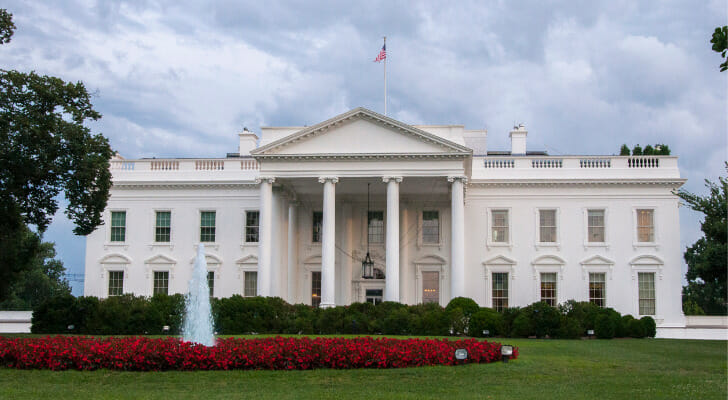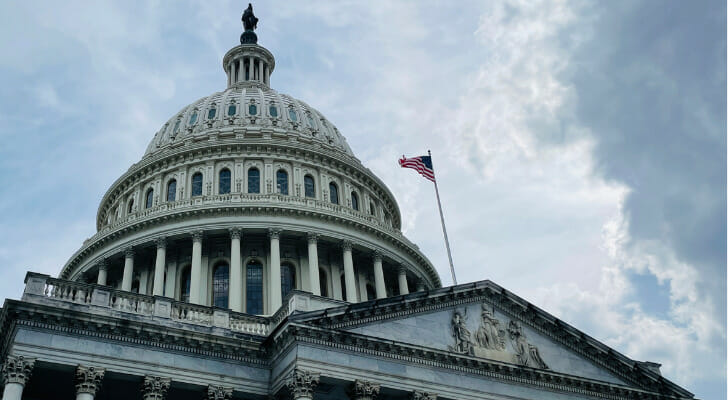In January, the Treasury ran out of revenue to continue paying the government’s bills. Ordinarily, when the Treasury needs to spend more money than it collects in taxes, it issues new bonds. However, as of last month it reached a statutory cap known as the debt ceiling.
According to Treasury Secretary Janet Yellen, the agency can employ accounting gimmicks known as extraordinary measures for several months, however by early- or mid-June, those measures will run out. When that happens, the government will need to authorize new borrowing or it will begin to default on its bills and spending obligations.
Given the tense divisions in Congress, some economists and analysts are worried that Congress might fail to raise the debt ceiling in time to continue paying the government’s bills. To keep that from happening, some are floating ideas for how to prevent default without new debt, such as the trillion dollar coin.
For help determining how the debt ceiling could affect your money, consider matching with a vetted financial advisor for free.
What Is the Debt Ceiling?
The debt ceiling is a federal law that caps how much money the government can borrow at any given time. It’s a quirk of budgeting held over from World War I, when Congress passed the law so that the Treasury could more easily borrow money to pay for the war. This repealed an old system, under which Congress had to authorize every new bond alongside every new spending package, and let the Treasury issue debt on its own authority up to a limit.
Critically, the debt ceiling is not a limit on future federal spending. Congress authorizes federal spending each year through the annual budget, which sets the government’s obligations on everything from Social Security and military salaries to educational grants and air traffic control. The Treasury distributes that spending using the revenue from taxes, also authorized by Congress. Most years, Congress spends more than it collects in taxes, in which case the Treasury borrows to make up the difference.
The problem comes from the conflict between these several laws. In the federal budget, Congress requires the Treasury to spend money. In the tax code, it requires the Treasury to collect money. And in the debt ceiling, it limits the Treasury’s authority to borrow. If the Treasury has bills to pay, but neither tax revenue nor borrowing authority, it will be legally required to default on the bills that it is legally required to pay.
Think of it like paying for dinner at a restaurant. Customers accrue a tab when they order their food at the start of the meal and pay for those expenses when their bill arrives at the end. If they don’t have enough money, they can borrow from a credit card or a friend. The debt ceiling is like setting a credit limit after the meal has already been eaten because the diners want a smaller check. Customers can cut their spending by ordering less the next time around, but the current bill is already due and simply refusing to pay would come with severe consequences.
To avoid those consequences, some economists and lawyers suggest that the president could avoid a debt confrontation altogether by simply minting a new coin worth $1 trillion. It has become known, colloquially, as “The Coin.”
How Does a Trillion Dollar Coin Work?

Ever since the first debt ceiling standoff in 2011, legal scholars and economists have been suggesting alternatives to this law. Most agree that the best solution would be simply to eliminate the debt ceiling altogether as an arguably illegal anachronism. Failing that, one proposal is for the Treasury to mint a $1 trillion coin.
Under this solution, the Treasury would order the U.S. Mint to produce a coin with a face value of $1 trillion. The Treasury would then put this coin on deposit with the Federal Reserve which, among other duties, acts as the banker that manages the federal government’s general accounts. This would add $1 trillion to the government’s bank account which it could then draw on to issue payments as necessary, in the same way that a consumer receives $100 in his checking account when he hands the teller a $100 bill. The only difference is that a $100 bill can circulate, because it has been printed in a usable denomination. Short of purchasing the Netherlands, the Federal Reserve would be unable to spend the $1 trillion coin in any realistic transaction.
This would allow the government to continue paying its bills without needing to borrow new money, because the Treasury’s account would have an additional $1 trillion of liquidity.
On one level, there is no significant dispute that the U.S. government a whole can issue new currency to pay its bills. Like all major economies, the U.S. operates on what is known as a “fiat” currency system, meaning that the government can determine how many dollars are in circulation based on its own authority. Most forms of currency, however, are set by statute, meaning it would take an act of Congress to print a $1 trillion bill.
However the $1 trillion coin may be legal based on a legislative loophole in the Mint’s coinage law. Specifically, while most of this law specifically outlines the Treasury Secretary’s authority, in 1997 Congress added a section intended to let the Mint raise money by selling commemorative coins. This section, paragraph k, reads in its entirety:
“The Secretary may mint and issue platinum bullion coins and proof platinum coins in accordance with such specifications, designs, varieties, quantities, denominations and inscriptions as the Secretary, in the Secretary’s discretion, may prescribe from time to time.”
Proponents of the trillion dollar coin solution argue that this gives the Treasury, and by extension the president, authority to mint new money at their own discretion as long as it meets the requirements of this section. Since those requirements are only that the coin be made of platinum, the president can order the minting of a platinum coin with a $1 trillion denomination and have it qualify as legal tender.
Critics suggest that the issue is nowhere near so simple.
Setting aside the inflationary questions posed by adding $1 trillion worth of potential liquidity into the economy, many lawyers argue that the coinage statute does not give the president this authority. As the noted legal blog Dorf On Law discussed, minting a $1 trillion coin would only work one of two ways. Under one option, the Treasury would leave the coin on deposit permanently. This would act as a massive new currency issue, which is power reserved for Congress. Under another option, the Treasury would pay the Federal Reserve $1 trillion in bonds when it has new borrowing authority and take the coin back. This would make the coin act as effectively a debt instrument, which the debt ceiling restricts.
In both cases, the trillion dollar coin would let the President use a law intended for collectibles to take powers typically reserved for Congress. While separation of powers is not a clear-cut area of the law, the Supreme Court typically requires that one branch of government have unambiguous authority before it usurps power from another branch. Here, the president would be effectively attempting to take over revenue and borrowing authority from Congress on an accidental technicality, and that may not survive the inevitable legal challenge.
Are There Other Solutions?
Failing the trillion dollar coin, legal scholars suggest two other main alternatives. First, there is the 14th Amendment approach. Under this theory, the president could order the Treasury simply to continue borrowing money as usual. Its authority would come from Section Four of the 14th Amendment which reads, in relevant part, that “[t]he validity of the public debt of the United States, authorized by law… shall not be questioned.”
By passing the federal budget and tax code, Congress authorized its debts by force of law. Not paying those bills would call the validity of this debt into question which, under this theory, is unconstitutional. This theory says that the debt ceiling has the same force of law as a nonbinding resolution. Congress is free to pass it, but it cannot conflict with the government’s constitutionally mandated duty to pay its bills.
Critics of this theory argue that, while it has superficial appeal, the public debt section of the 14th Amendment has been applied rarely in legal history. There is little case law to back this section up, and so there’s no strong guide for how the Supreme Court will interpret it.
Finally, there is the legislative conflict theory. Here, too, the president would order the Treasury to simply ignore the debt ceiling. Under this theory, the debt ceiling does have the force of law. However, so does the federal budget and the federal tax code. This creates a conflict between three equally valid laws. The president must break the law by either spending less than required, taxing more than allowed or borrowing more than authorized. No other outcome is possible.
Again, the law is murky on issues of legislative conflict. Among other options, when the president cannot enforce multiple laws simultaneously, he arguably has discretion over which law to prioritize. Since the Treasury must either disregard the debt ceiling or the budget, the president can order it to prioritize the budget over the debt ceiling.
The president must break one law, but there’s nothing that says he must choose the law which entails catastrophic default.
Bottom Line

The trillion dollar coin is a solution that some economists and legal scholars have proposed to the periodic debt ceiling crisis, an issue created when Congress does not authorize the Treasury to borrow enough money to cover past spending. Under this theory, the president would order the U.S. Mint to create a coin with a face value of $1 trillion. Once deposited in the Federal Reserve this would, in theory, boost the government’s balance by $1 trillion in the same way that handing the teller a $100 adds that to your checking account.
Tips For Navigating Debt Ceiling Fears
- The debt ceiling really is a big deal, and on a personal level. Here’s how it could hit your retirement accounts, your Social Security and even Medicare.
- While the debt ceiling is a disaster that doesn’t have to happen, it’s always best to be prepared. With SmartAsset’s matching tool you can find a financial professional near you to help you build a portfolio that can manage risks as well as opportunities. Finding a financial advisor doesn’t have to be hard. SmartAsset’s free tool matches you with up to three vetted financial advisors who serve your area, and you can interview your advisor matches at no cost to decide which one is right for you. If you’re ready to find an advisor who can help you achieve your financial goals, get started now.
Photo credit: ©iStock.com/Douglas Rissing, ©iStock.com/Feverpitched, ©iStock.com/Mauro_Repossini
